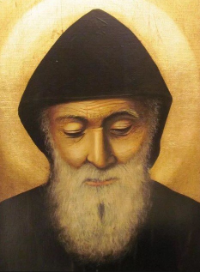Parish Relic
-
-
St. Charbel Makhlouf, Priest
† 1898
Feast Day: July 24 Born on May 8, 1828 in the mountains of Lebanon, Yussef Makhlüf joined a Maronite monastery at age twenty-three, taking the name Sharbel (or Charbel). He was ordained a priest, his heart centered on the divine office and the Mass, and remarkable for his practice of detachment and obedience. It is said he could stop a pickaxe in mid-swing if his superior called. When he was seventy, he was taken ill while offering Mass and died a few days later, on Christmas Eve.
monastery at age twenty-three, taking the name Sharbel (or Charbel). He was ordained a priest, his heart centered on the divine office and the Mass, and remarkable for his practice of detachment and obedience. It is said he could stop a pickaxe in mid-swing if his superior called. When he was seventy, he was taken ill while offering Mass and died a few days later, on Christmas Eve. He was buried quickly, his body placed directly in the ground without a coffin. After his death, a light was observed around his gravesite for forty-five days. At the request of the locals, the grave was opened. Sharbel's corpse was discovered floating in mud. Though not unchanged, it was intact and flexible and it exuded an unusual liquid, like red and clear blood.
This phenomenon continued for years, even when the body was reburied in a tightly sealed coffin. When Saint Sharbel made an inexplicable appearance in a 1950 photograph - a likeness testified to under oath by many witnesses - the hand appeared as it did on his corpse.
Only a skeleton remained by 1976, but the relics* continue to work miracles, including the 2016 healing of an Arizona woman from blindness.Heavenly Father, through the prayers of Saint Sharbel, may we offer our lives to you and receive wonders from your hands.
printed in its entirety from Magnificat magazine with the permission of the Magnificat publishing team
Saint Charbel is considered by many to be the masculine counterpart of the Little Flower of Lisieux. He led a hidden life of profound virtue, humble labor and ardent fervor for the Holy Eucharist. His body remained intact for over seventy-five years after his death and exuded a miraculous oil that healed a great number of crippled and sick people.
-
-
-
*St. Charbel's first-class relic resides near the tabernacle in our chapel.
-
